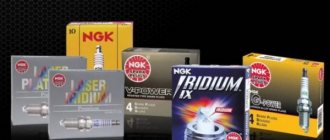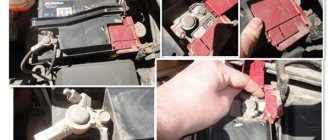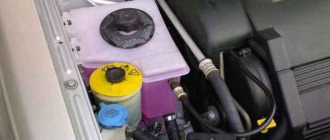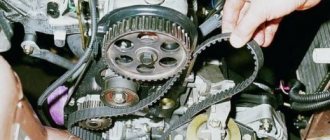Spark plugs are an important element of any engine. These elements are involved in the process of ignition of the fuel mixture. The candle has a fairly durable construction. But the part operates under high loads and is subject to wear. In addition to natural wear and tear, this element is also affected by low-quality fuel. Spark plugs need to be changed periodically. Let's look at what the frequency of replacing spark plugs should be, how to determine when it's time to change a part, and also find out what the gap should be.
About replacement intervals
If the machine is under warranty, then in any case all maintenance work is carried out strictly in accordance with the manufacturer’s regulations. Different car manufacturers regulate the replacement of spark plugs at different mileages. Often this is a period of 40-80 thousand kilometers. These numbers have a huge range. The fact is that different cars have different spark plugs.
The replacement interval depends on the materials and technologies used in the production process of the element. Also, the frequency of replacing spark plugs depends on their resistance to high temperatures (heat rating) and voltages.
Replacement procedure
To replace the spark plug, you first need to pull out the plastic cover of the motor (if equipped). Then you need to remove high-voltage wires from all spark plugs. On many machines, the wires are attached to the spark plugs using clamps, which you just need to press and then pull towards yourself, after which access to the spark plug itself will open. This procedure must be repeated with each wire. Next, using a spark plug wrench, unscrew all the spark plugs. When the candle goes very tightly, then you don’t need to press it hard so as not to damage the ceramic surface (otherwise big problems will arise). Basically, the spark plugs are quite easy to unscrew.
How often to change spark plugs if the car is not under warranty
Ideally, the replacement will be made with every engine oil change. On average it is 15-20 thousand km. But some people change the oil more often, for example, every 8 thousand, which is very important for cars that are in use in our country. In addition, if it is necessary to install branded spark plugs for the engine, then such a replacement will not be cheap. And such a frequent frequency of replacing spark plugs will not save money. How long can a candle really work?
And here experts recommend not to delay the replacement of parts, no matter how high quality they are. Even a spark plug with iridium or platinum coating in our country should be replaced with a new one at least every 40-50 thousand kilometers.
If the engine is equipped with a cheap brand of spark plugs from Auchan, then these elements must be replaced with new ones at least once every 10 thousand kilometers. A cheap candle has a significantly shorter lifespan, unlike an expensive one. But don't forget about fakes.
Why change spark plugs if the old ones work?
p, blockquote 32,0,0,0,0 –>
Theoretically, they can last ten years or more, especially if they are cleaned periodically.
p, blockquote 33,0,0,0,0 –>
There is an opinion that spark plugs should be changed only when obvious signs of wear appear, or when repairs related to problems with ignition and the engine as a whole are carried out. However, old, although serviceable, spark plugs can negatively affect engine performance:
p, blockquote 34,0,0,0,0 –>
- changing the gap area affects the ignition timing;
- minor misfires lead to increased detonation and mechanical stress;
- dirty spark plugs can cause breakdown of the ignition coil, high-voltage wires, and slider resistor;
- Incorrectly functioning spark plugs affect the environmental characteristics of an internal combustion engine.
The most dangerous problem when replacing spark plugs infrequently is coking of the threaded connection area.
. This is fraught with the possibility of thread breakage and damage to the spark plug during dismantling. In turn, such a malfunction may lead to the need for major repairs, even replacement of the cylinder block.
p, blockquote 35,0,0,0,0 –>
Therefore, experienced car enthusiasts carry out preventive dismantling and installation before the next autumn-spring season of car operation. At the same time, you can (and should) make a visual inspection of them.
p, blockquote 36,0,0,0,0 –>
Serviceable and serviced spark plugs are one of the main factors in the stable operation of a gasoline engine.
p, blockquote 37,0,0,0,0 –>
What is the operating principle of viscous fan couplings, their pros and cons.
How and where you can see what the traffic police fine is for by the resolution number.
Video - spark plug wear and when to change them:
p, blockquote 39,0,0,0,0 –> p, blockquote 40,0,0,0,1 –>
When it comes time to change the spark plugs in a car, drivers are faced with a difficult choice: they can get by with a cheap copper set or buy something more expensive but more reliable. Now a worthy competitor to platinum spark plugs are iridium spark plugs, which are becoming more and more popular every year in the production of auto parts. In general, iridium recently began to be used for the production of machine spark plugs. It wasn't until 1994 that NGK demonstrated iridium spark plugs for the first time.
Then it became a real breakthrough. The innovation quickly came into use. Among the advantages, it was noted that iridium is excellent for use in vehicles, since it has a very high melting point and increased resistance to corrosion. Soon, NGK created and launched on the market the thinnest electrode wire, for the tip of which the electrode material iridium began to be used.
If we talk about the DENSO , their iridium spark plugs are made specifically for modern generation gasoline engines. The company appeared later in 1996 in Japan, but despite this its products are also widespread. The DENSO spark plug consists of a central electrode, which is made of chromium-nickel alloy with a copper core, this gives high thermal stability and an extended operating range.
Symptoms of dying candles
If the spark plugs are faulty, the engine will start to stall. It will jerk when driving and also at idle. There are also problems starting the power unit. The starter will spin the flywheel, but the engine will not start. The spark may disappear if the gap on the spark plugs is too large. Fuel consumption and the amount of carbon dioxide in the exhaust gases will increase. Also, faulty spark plugs are diagnosed by worsening dynamics. The engine will not rev like before. Its power will also decrease.
If you ignore all these symptoms, then after some time the motor may fail. Do not neglect regular replacement. It's cheaper than a major overhaul.
One of the saddest consequences is detonation in the cylinder. As a result, a blast wave is formed, which, depending on the amount of fuel mixture, can cause the entire charge in the combustion chamber to detonate. During strong vibrations, the engine will experience mechanical and thermal loads close to maximum. As a result, pistons, cylinder head gaskets, and the spark plugs themselves burn out. The shock wave breaks the oil film in the upper parts of the cylinder. This entails increased wear of the crankshaft parts.
How to replace a spark plug
Watch the video below to see how to replace a spark plug correctly and quickly.
For many car enthusiasts, the question of when is the best time to change spark plugs - within the period recommended by the manufacturer of the car or the spark plugs themselves, or judging by their actual condition, is the same stumbling block as whether to drive on 92 or 95 gasoline . Some car owners strictly adhere to the regulatory deadlines, believing that the car manufacturer knows best when it is best to replace this consumable item. Others believe that since the spark plugs are in good condition, the engine is in good condition even in severe frost, then they need to be changed no earlier than 60-90 thousand kilometers. Let's figure out what can happen to a car if you don't change the spark plugs within the time limits specified by the manufacturer.
Why does the engine need spark plugs?
First, let's remember what function spark plugs perform in an engine. These devices are needed to ignite the fuel-air mixture in the combustion chamber (cylinder) of the engine by the spark formed during the ignition switching on. This mixture is ignited using an electrical discharge of several thousand or tens of thousands of volts, which occurs between the electrodes of the spark plug.
A standard spark plug consists of several components:
Contact terminal (designed to connect the spark plug to the high-voltage wires of the ignition system or directly to the ignition coil);
Insulator (protects the spark plug from overheating; the part of the insulator directly adjacent to the central electrode most strongly affects the quality of the spark plug);
Insulator ribs (prevent electrical breakdown along its surface);
Central and side electrodes (a spark occurs between them, igniting the fuel-air mixture in the cylinder);
Seal (serves to prevent the penetration of hot gases from the combustion chamber).
An important characteristic of any spark plug is the size of the gap between the central and side (side) electrodes. It depends on it how effectively the mixture in the cylinder will be ignited. The larger the gap, the more powerful the spark and the larger the ignition zone. Accordingly, fuel will burn more efficiently, which means its consumption will be stable and engine operation will be smooth. On the other hand, when the gap between the electrodes of the spark plug is smaller, the spark appears earlier and breakdown occurs at a lower voltage. But at the same time, the spark energy is less, which is worse for igniting the mixture, and ultimately, with a reduced gap, the power and economical characteristics of the engine are reduced.
Also an important characteristic of spark plugs is their heat rating - this is information about the maximum permissible temperature load of the spark plug. Domestic spark plugs are produced with heat numbers of 8, 11, 14, 17, 20, 23 and 26. Foreign manufacturers do not adhere to a single heat number scale. Depending on the heat value, candles are divided into “cold”, “hot”, medium and unified. If you install spark plugs that are too “cold” (with a high heat rating), their self-cleaning process will become difficult and the engine will run intermittently. If they are too “hot”, so-called glow ignition is possible, which in its symptoms and destructive consequences resembles engine detonation.
What types of candles are there?
In everyday life, spark plugs are called classic, platinum and iridium.
They received such names because of the materials used to make electrodes. In classic spark plugs, the electrodes are made of copper, in platinum spark plugs they are made of platinum, and in iridium spark plugs they are made of a special iridium alloy. In some classic spark plugs, copper electrodes are coated with yttrium alloy for reliability, which increases the stability of the spark plug electrodes. Platinum spark plugs are good because platinum has high corrosion resistance and resistance to high temperatures (they practically do not burn out), which allows them to achieve a fairly long service life. Iridium spark plugs have characteristics similar to platinum spark plugs. But the most durable spark plugs are those in which the electrodes are made of an alloy of platinum and iridium.
Candle life
The service life of candles depends on many factors. Manufacturers determine the period of operation of these elements depending on the materials from which the electrodes are made, approximate operating conditions (climatic conditions, fuel quality, etc.). So, for classic spark plugs, the average service life is no more than 50 thousand kilometers. For platinum and iridium - no more than 90 thousand kilometers. Naturally, these figures can be adjusted depending, for example, on the quality of gasoline that is poured into the car and the condition of the engine itself. Therefore, many car manufacturers recommend replacing classic spark plugs during every second scheduled maintenance (for example, after 30 and then 60 thousand kilometers). When using platinum or iridium spark plugs, the service life can be increased by one and a half to two times.
What happens if you don’t change the spark plugs in time?
Let's say that for some reason the period for replacing the spark plugs, as prescribed by the regulations, has expired, and the car owner did not bother to install new elements. Perhaps this will not immediately lead to any tragic consequences for the car’s engine. But one day the car simply won’t start. Therefore, we advise you to pay close attention to signs indicating that your spark plugs are about to fail.
Signs of faulty spark plugs include:
— “triple movement” of the engine (it jerks when driving and at idle)
Difficulty starting the engine (the starter fires, but ignition does not occur)
Increased fuel consumption
Increased CO emissions
Deterioration in engine dynamics (the engine does not develop maximum speed and, accordingly, its power decreases)
If you ignore the signs listed above, engine failure may occur.
One of the sad consequences of faulty spark plugs can be detonation in the engine combustion chamber. As a result of the detonation of a certain volume of the mixture, a shock wave arises, which, depending on the volume of the mixture, can have such an intensity that its energy will cause the entire charge remaining in the cylinder to detonate. When shock waves are reflected from the wall of the combustion chamber, a ringing metallic sound is produced. With severe detonation, the knocking becomes louder, engine power drops, and black smoke appears in the exhaust gases. Also, during severe detonation, the motor experiences large thermal and mechanical loads on some parts. The edges of the pistons and cylinder head gaskets and spark plug electrodes can burn. Shock waves destroy the oil film in the upper part of the cylinder, thereby causing increased wear.
You need to install spark plugs recommended by the manufacturer into your car engine, paying attention to their heat rating and other characteristics.
Despite the stable operation of the ignition system, the condition of the spark plugs must be checked at every scheduled maintenance
Long-term operation (mileage 50 thousand kilometers or more) is possible when installing spark plugs with platinum or iridium electrodes
To extend the service life of spark plugs, it is necessary, if possible, to fill only proven fuel, change filters on time, and ensure that the spark plug gap is set correctly
If signs of faulty spark plugs appear (“motor tripping”, increased fuel consumption, “floating” speed), immediately contact a service station or replace these elements yourself with new ones.
Not every motorist knows that spark plugs need to be changed within the time specified by the manufacturer, and not when they stop working altogether. This is done for many reasons, which we will talk about in this article. When to change spark plugs, how to do it yourself - you will learn all this from this article.
Reasons for the formation of black soot
When checking a part visually, many novice car owners are frightened by black carbon deposits on the spark plugs. The reasons for this phenomenon may be different. The type of soot itself will tell you how the engine works.
A black, greasy, oily deposit that forms on the electrode and on the threads indicates a large amount of oil that is entering the cylinders. It gets there due to worn valve stem seals, piston rings or valve guides. The spark plugs in this case are not the cause of the problem.
Let's look at dry black carbon deposits on spark plugs and the reasons for its formation. The first symptom is a malfunction of the spark plugs, which may indicate a weak spark. The second reason is low compression. If velvety carbon deposits are noticed, it is worth checking the pressure in the cylinders.
On older gasoline engines, black carbon deposits may indicate incorrect carburetor settings. In inverter engines, this indicates problems in the fuel pressure regulator. Another reason is that the mixture is too rich. Also, black carbon deposits on the spark plug may indicate a clogged air filter. The latter changes every 10 thousand kilometers.
Diagnostics with a multimeter
Using this device, you can check whether there is a short circuit inside the part.
But the fact is that after such a diagnosis it is difficult to talk about the serviceability of the spark plug. For testing, the wires from the multimeter are connected in such a way that one cord is connected to the output, and the second to the base. After this, a spark should appear.
Diagnostics using the device
A spark plug tester is a gun that can be used to test a spark plug for functionality. Checks are often carried out under pressure. This device can be purchased at any major auto store.
To begin testing, the candle is inserted into the groove and a special cap is put on. Next, pull the trigger of the gun and see if a spark appears and the light comes on. If everything is so, then the part is working. But again, it is difficult to get a 100% guarantee on such a device.
If the spark on the test bench is good, it is not a fact that the same spark will be in the engine. There is a completely different pressure in the combustion chamber. But if the candle does not work in the device, it is definitely no longer alive. It is better to replace them as a set.











